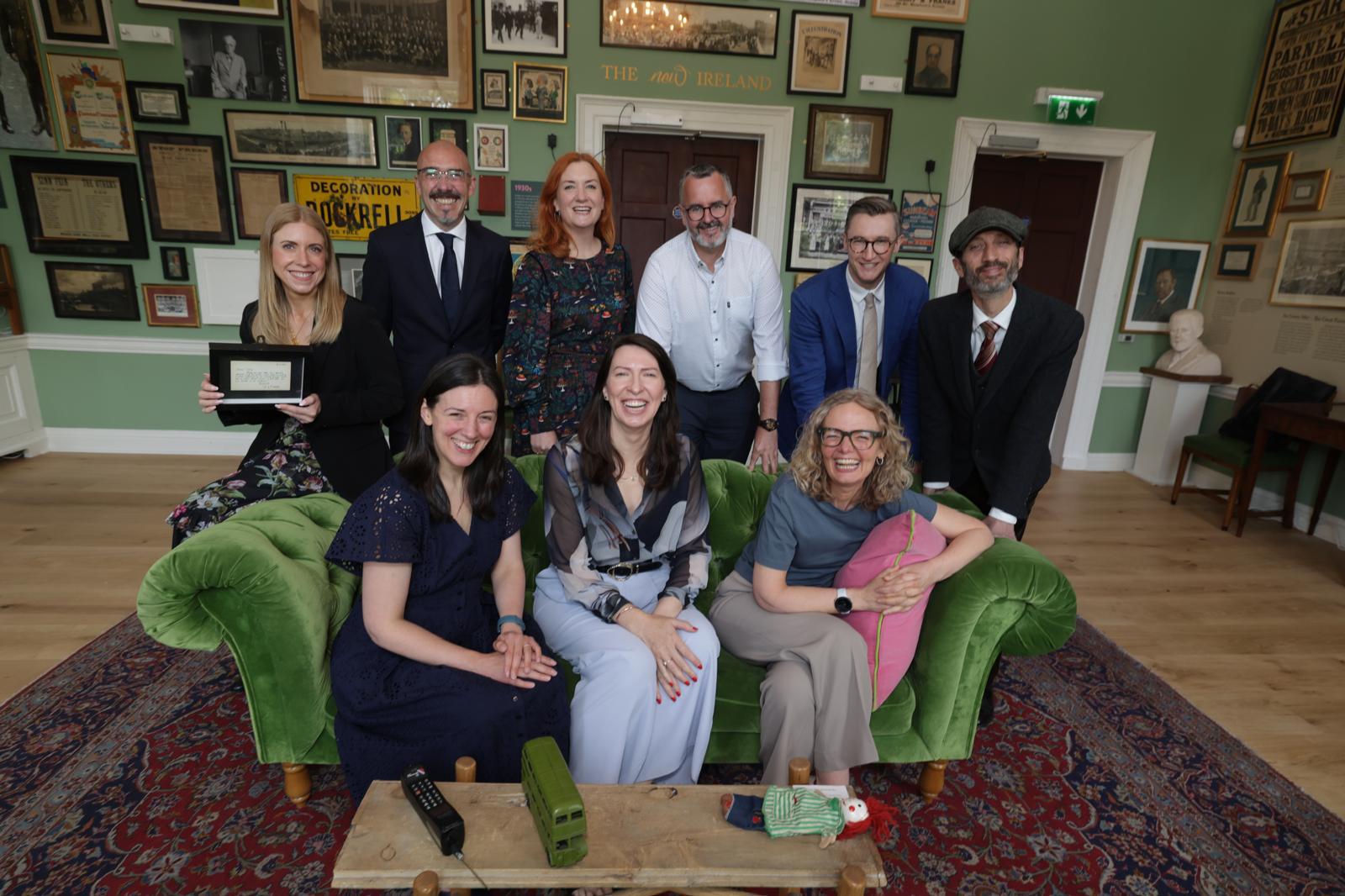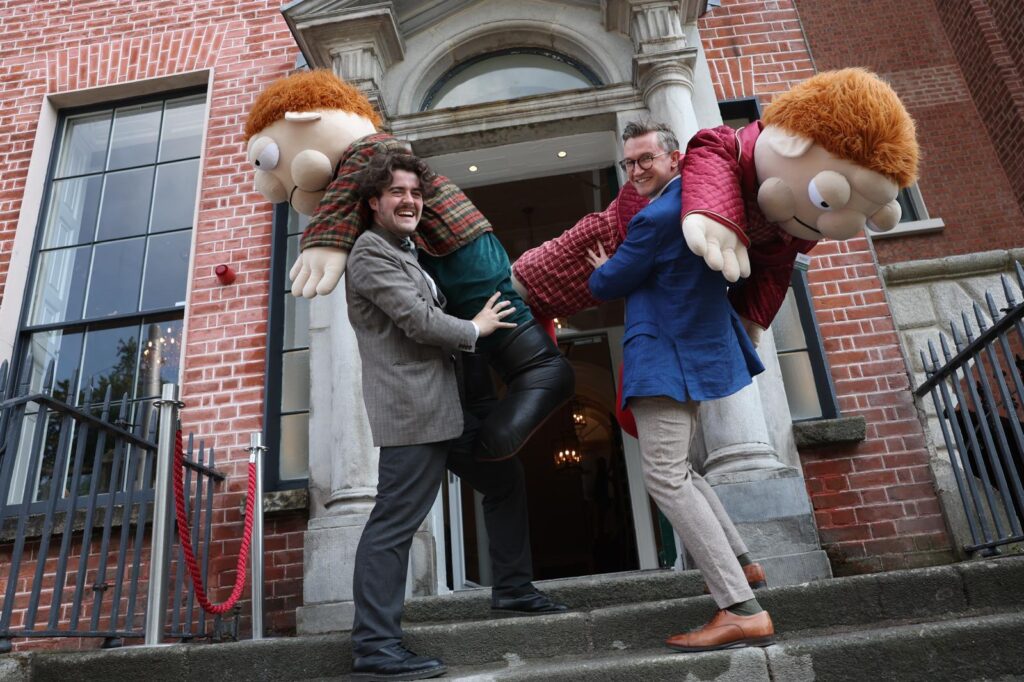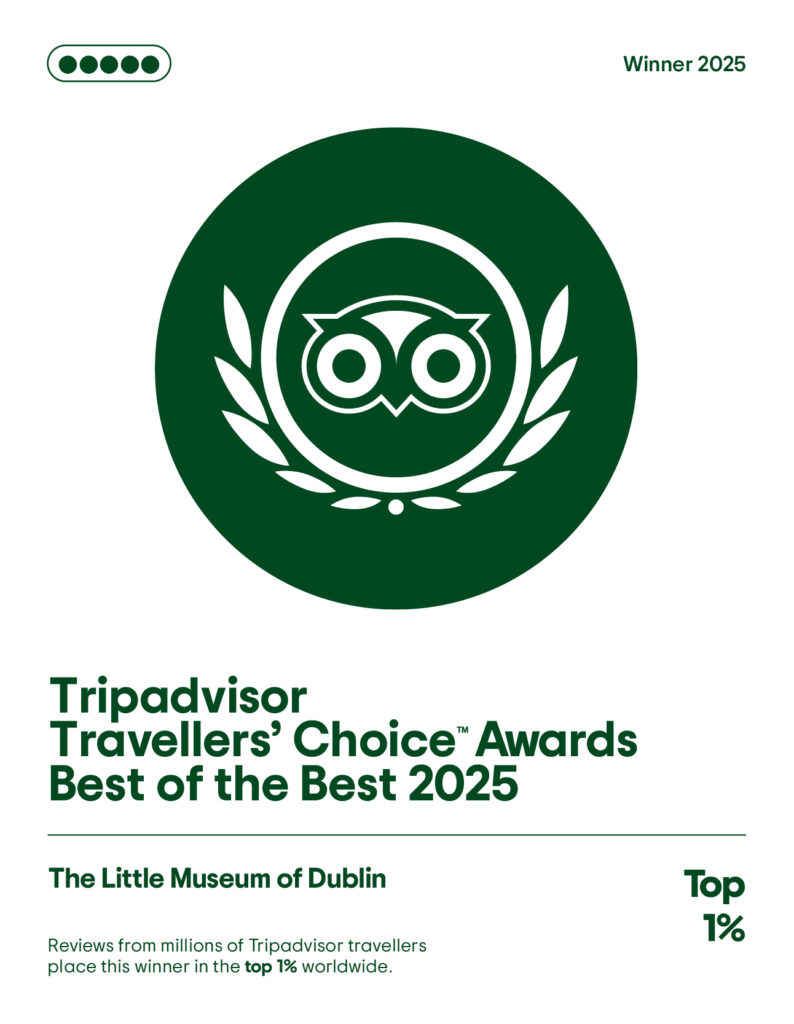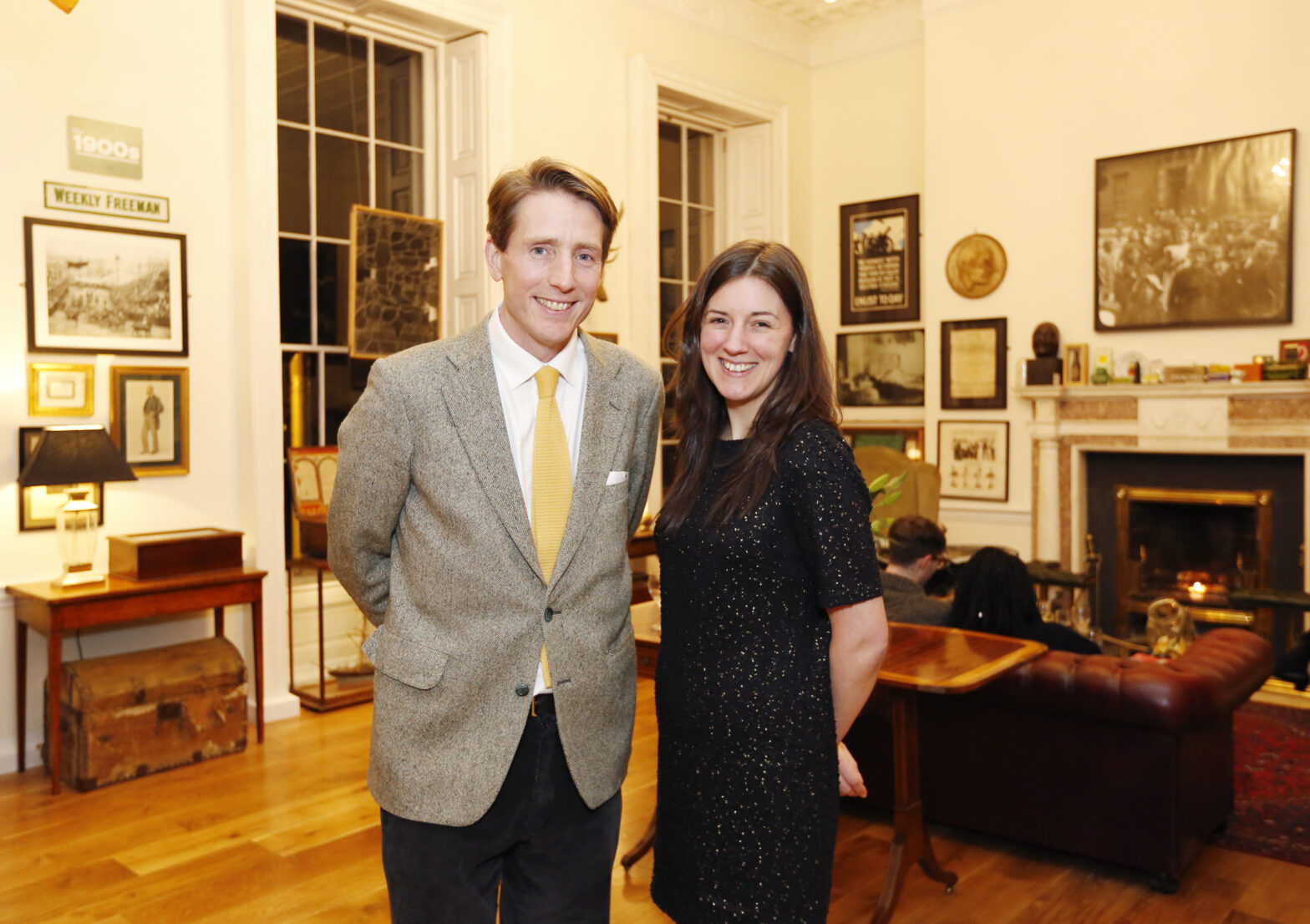By our founder, Trevor White
JULY 2025: The Little Museum has reopened on St Stephen’s Green after a multi-million euro renovation, funded by the museum with support from Fáilte Ireland, Dublin City Council, the Department of Tourism, Culture, Arts, Gaeltacht, Sport and Media, and a small group of philanthropists.

As we return to the Green, I want to come clean about our links to some mysterious characters on the fringes of polite society. I refer to our patrons, staff, benefactors and friends. They helped to turn a small non-profit museum into an international success story for Dublin at a fraction of the cost of a traditional city museum.
This is the story of how some outsiders who had never worked in a museum opened a museum – and some of the people who helped them to make it happen. Who’s Who in the Little Museum.
In a collection created by public donation, the work is of, by and for the people, so the most important person in this Who’s Who is anyone who has ever gone on a tour, read one of our books, watched one of our films, glanced at this website or donated an artefact. That spirit is exemplified in our permanent collection, created by the people of Ireland. The Little Museum is a chapter in the history of social capital.
Our second nominee – after you! – is Frank Feely, the city manager who dreamed up the Dublin millennium celebrations in 1988. It was Feely and a civics teacher in Sandford Park, Roger Bennett, who were responsible (though neither knew it at the time) for encouraging my interest in civic pride, which can loosely be described as the love that a place has for itself.
Back in 1988, I was sixteen years old, and in the market for an uncomplicated loyalty to something. Was Dublin an obvious choice? It depends. My grand-parents were Roman Catholic, Quaker, Scottish Presbyterian and Lithuanian Jewish. As a child, longing for a firm identity, I had two convictions: the first was that I was born in Dublin. The second was that I fancied the girl next door. That one didn’t go my way.
The millennium wheeze – remember, no one really knows how old Dublin is – appealed to something in my personality, because I have always admired cultural entrepreneurs. People who stage-manage the future. I am thinking of my father, estate-agent-turned-restaurateur Peter S. White, and his cousin Michael White, who produced the Rocky Horror Show. I appear to come from a long line of carnival barkers.
Here in Dublin, my early mentors included several men who could also be described as cultural entrepreneurs. There was Desmond Fitzgerald, the Knight of Glin, and a trio of media proprietors: Dublin Event Guide founder Conor Owens, In Dublin editor John Ryan, and Image publisher Kevin Kelly. It was Kelly who taught me how to sell ideas. This dynamic magazine publisher brought me to London and New York, from Food and Wine to America’s Elite 1000, the much-hyped ‘yellow pages for billionaires’. It was a useful introduction to the business of selling ideas. Great things might happen if you just sign here!
In the autumn of 2000, I came home to launch The Dubliner, a magazine of ideas that was read by hardly anyone. For eight years we struggled to find an audience. At its best, the monthly magazine was like a kitten scratching at the leg of democracy. At its worst, it was topless. In November 2008, I sold The Dubliner to another publisher, Michael O’Doherty, who has since become a successful barrister in addition to his publishing interests. Who knows how much he saves in legal fees?
One night in November 2010, I met my friend Cilian Fennell – television producer and communications consultant – for a drink in the Swan Lounge on Aungier Street. Cilian and I fell into conversation with a young Australian who had just checked into a hostel across the road. “I heard that Dublin was a friendly place,” he said. “So here I am.”
To encourage the young man’s reverie, we bought him a pint and recommended places to see. Afterwards, Cilian and I declared the meeting a success, and I rushed home, woke up my wife, Susan Jane, and proudly announced that I was going to start a greeter programme to make Dublin the friendliest place in the world. Her exact words:
“Did you remember to put the bins out?”
A few days later, I went into Dublin City Council, told them about my plan, and was met with a chorus of sighs. Leaving Wood Quay, I bumped into Councillor Mannix Flynn.
“What are you up to?” he said.
“I’m trying to start a greeter programme.”
“A what?”
“And a museum.”
“A museum?”
“Yes. A museum of Dublin. Where we can host the meetings.”
“Leave it with me,” he said.
Mannix thought it should be possible to open a museum of Dublin with the help of Dublin City Council. He did not mention any concerns within the Council, or the fact that DCC becoming the patron of an independent city museum might not please everyone. This artist-politician saw past my naivete to recognise the public good in play.
That night I met Simon O’Connor for a drink. A former art director in The Dubliner, Simon was the sort of person who could pass for a curator, though he had never worked in a museum. “We’re going to open a museum of Dublin,” I said. “I’ll be the director, and you’re going to be the curator.” And I’ll never forget what he said next.
He said, “Nah.”
Three pints of Guinness later, Simon O’Connor was appointed as the first curator of the Little Museum. And I was the director. (Sometimes Guinness really is good for you.) Cut to the bunkers of power in Wood Quay, where we pitch up for another meeting with Dublin City Council. Only this time it’s an assistant city manager, Michael Stubbs, and his number two, Declan Wallace.
“Mannix says you want to open a museum.”
“That’s right.”
“He says you have a plan.”
“Yes,” I said, “Dublin needs a hug. The museum will encourage people to see their capital in a new light. We’ll open and run this museum for a fraction of what it would otherwise cost the state. And our greeter programme, City of a Thousand Welcomes, will prove Dublin’s reputation as one of the friendliest cities in the world. Well?”
Wallace and Stubbs offered us the basement of a beautiful Georgian house. “Thank you,” I said, “but you don’t bring your visitors to the basement. Have you any room upstairs?”
A flat no. End of meeting. We had overplayed our hand. Sorry, I had overplayed our hand. Is that right? Are you sure? You’re right. For a few days, nothing – then nothing. Then Michael Stubbs rings to say yes, we could have two rooms on the first floor of No. 15 St Stephen’s Green. For eleven months. “To see if the project has legs.” That was the start of an important relationship with Dublin City Council.
Simon was not the only survivor from the world of publishing. The fingerprints of the magazine are all over the museum. Lawyer Ed Brophy was our first chair. Ed once wrote a column in The Dubliner. Our first editor, Emily Hourican, was also one of our first board members, and my erstwhile rival Joan Fitzpatrick, who once managed the In Dublin stable, was also on the board. So, too, was The Dubliner’s accountant, Brian Geraghty, who became our first treasurer. When Domini Kemp opened Hatch and Sons, I wonder how many people knew that ten years earlier we had co-edited a best-selling guidebook called The Dubliner 100 Best Restaurants? Or that it was sponsored by Terry Pennington of Santa Rita, who remain patrons of the museum to this day?
‘Think where man’s glory most begins and ends,
And say my glory was I had such friends.’
On the 4th of March, 2011, I roped seven friends into becoming the founding ‘subscribers’ of the Little Museum of Dublin, a legal necessity for a non-profit company. Most had a Dubliner connection: Cilian Fennell, entrepreneur Paddy Cosgrave, art historian Nicola Gordon Bowe, barrister Aillil O’Reilly, comedian Abie Philbin Bowman, Camile Thai owner Brody Sweeney and auctioneer Ian Whyte.
We had some good people, then, and the bones of a plan: to make a public appeal for assistance on Marian Finucane’s radio show. The response to that appeal speaks to the extraordinary generosity of the Irish people. (We were completely unprepared.) Within the next 14 days, the museum was offered just over a thousand artefacts. The truth is that RTÉ Radio 1 listeners imagined the museum into being. Fourteen years later, it is the custodian of over 5,000 artefacts.
The response to that appeal helped me to persuade John Concannon of Fáilte Ireland (today, John is the Irish Ambassador to Canada) to sign off on a €40,000 grant, and with another €25,000 from the Dublin Regional Authority, I assured Simon that everything would be fine. “Whatever happens, I promise you’ll be paid until Christmas.” I have since discovered that this is the primary role of a business leader: to believe that success is possible, and encourage that delusion in others.
On the 16th of September, 2011, the Little Museum of Dublin was opened by the then-Lord Mayor, Councillor Andrew Montague. The applause was polite. Mannix made only a fleeting visit. My wife appeared with our infant son in her arms. About a month later, Frank Feely came on a tour. I’m sure the ex-city manager thought I was spoofing when I told him that the millennium celebrations of 1988 ignited my passion for the city. Sincerity is so rare in Dublin that it usually avoids recognition.
For the first eleven months, our licence restricted the museum to the first floor. In 2012, we had 24,248 guests, but over time we colonised the rest of the building, and in 2019 we had 120,993 guests. They included Mary Robinson, who was too modest to sign the election poster for her 1990 Presidential campaign, and Bob Geldof, who complained that Bono got a whole room to himself. Only he didn’t put it quite like that.
These days, our guided tour is recognised as one of the best museum experiences in Europe. Only three things happen on that tour: history, humour and hospitality. The secret sauce in a museum that thinks it’s a theatre: “the most fun you can have in Dublin with your clothes on,” as a customer put it on Google Reviews.
I work with, and for, many strong women. I am thinking of Nicola Gordon Bowe, who died in 2018, a great scholar and a sparkling human being. I am also thinking of colleagues such as C.E.O. Sarah Clancy and C.O.O. Noeleen Murphy; Councillor Mary Freehill, former Lord Mayor of Dublin, who sat on our board for many years; our current chair, Dr Rhona Mahony, proud northsider and civic leader; and another board member, Catriona Crowe, a fearless champion of public access to information about dark corners. These formidable women are the sort of people who keep the furniture of democracy in its place.
The Little Museum 2.0 features many of its founder’s obsessions, including U2, Alfie Byrne – the legendary Lord Mayor – and Brendan Bracken, the mysterious founder of the modern Financial Times. A lift facilitates guests who were previously unable to visit. Building it was not a simple operation. Moston Construction had to gut the house under the close eye of Deaton Lysaght conservation architects. They both did an excellent job.

Do you remember how snooty I was about the basement? In the renovated museum, guests will arrive in the basement, to ensure parity of access for all visitors. That new lift means changes throughout the building, and some will require tweaking. There is no perfect accessibility fix for a house that is nearly 250 years old. But we have made a start.
Fiona McDonnell’s mural about Senator Eileen Flynn is the only artefact that remained in situ as the building was renovated over the last 14 months. This powerful installation is now joined by new work from artists Sinead McGuinness, Mick O’Dea, Andrew Clancy, Vera Klute and Maser. The latter’s huge mural of Daniel O’Connell has been erected in our back garden, making a colourful addition to the museum experience.
Photography takes centre stage in the renovated museum, with arresting portraits by Mike Bunn and Conor Horgan, as well as street photography by Mick Brown, Alan MacWeeney, Charles Cushman, Eric Luke and Brendan Walsh. A Dublin photo essay by Pulitzer-prize winning photographer Deanne Fitzmaurice will be the subject of a temporary exhibition in the museum later this year.
We welcome the jewel-box charms of Tara’s Palace – with a stagelit story of its own – and we welcome back a theatrical installation, You can leave at any time, about the life of Magdalen laundry survivor Mary Merritt. Originally produced for the Dublin Theatre Festival, and influenced by the work of theatre maker Louise Lowe, this is a powerful piece of storytelling on a tiny scale, to be presented for an audience of one person every day.
While the renovations were underway, the main museum was closed, and we operated a pop-up on Pembroke Street for fourteen months. How did it go? There are 694 things to do in Dublin on the Tripadvisor website. The museum has been number one for the last three years. Today it is ranked as the number 12 attraction in Europe, just behind the Acropolis, but ahead of the British Museum. No one is more surprised than my wife.

Simon O’Connor – who left to open MoLI across the Green – returned to our team for the last few months, helping our head of design Dara Flynn to re-imagine the story of Dublin. Telling the story of a great city is an opportunity that most people don’t get once, let alone twice. In 2011, that work felt speculative. Thanks to the support of the state, the generosity of people like you, and the talents of a singular team, the Little Museum is coming of age, fourteen years after hustling its way into being.
I am grateful to everyone mentioned in this essay, and to all of my unnamed colleagues – who make magic happen in this building seven days a week – for helping to give Dublin the world-class museum it deserves.
Trevor White
July 23rd, 2025
